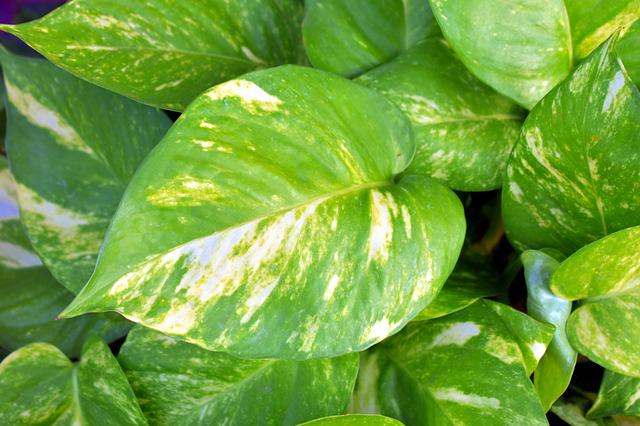Pothos plants are among the most popular houseplants worldwide due to their easy care requirements, striking appearance, and air-purifying qualities. These tropical vines belong to the Epipremnum arum species and come in various stunning cultivars, each with unique features. In this article, we will explore three remarkable pathos varieties: Neon Pathos, Cebu Blue Pathos, and Satin Pathos. We’ll discuss their characteristics, care tips, and how to incorporate them into your indoor plant collection.

1. Neon Pothos
Overview
Neon Pothos (Epipremnum aureum ‘Neon’) is celebrated for its vibrant, chartreuse foliage that brings a lively pop of colour to any indoor space. This cultivar is a favourite among plant enthusiasts, both for its aesthetic appeal and its easygoing nature.
Characteristics
– Leaf Color: Neon Pothos features bright, fluorescent yellow-green leaves that can light up any room. The vibrant color can fade to a more muted green in low-light conditions.
– Growth Habit: This variety has a trailing growth habit, making it ideal for hanging baskets, shelves, or as a tabletop centrepiece. It can reach up to 10 feet long if given the right conditions.
– Size: Leaves typically grow to about 4-6 inches long, with a heart-shaped appearance that’s characteristic of pothos plants.
Care Tips
– Light Requirements: Neon Pothos thrives in bright, indirect light but can tolerate low-light conditions. However, to maintain its vivid color, it’s best placed near a window with filtered sunlight.
– Watering: Water the plant when the top 1-2 inches of soil feel dry. Be cautious not to overwater, as this can lead to root rot.
– Soil: Use a well-draining potting mix enriched with organic matter. A mix designed for houseplants, containing perlite or vermiculite, works well.
-Temperature and Humidity: Neon Pothos prefers temperatures between 60-85°F (16-29°C) and thrives in moderate to high humidity levels. To increase humidity, consider misting the leaves or using a humidity tray.
Benefits of Neon Pothos
– Air Purification: Neon Pothos is excellent at filtering indoor air pollutants such as formaldehyde and benzene, contributing to a healthier living environment.
– Low Maintenance: This variety is forgiving and can tolerate various light and watering conditions, making it perfect for busy individuals or beginners.

2. Cebu Blue Pothos
Overview
Cebu Blue Pothos (Epipremnum aureum ‘Cebu Blue’) is a stunning variety known for its unique blue-green foliage and distinctive leaf shape. Native to the Cebu Island in the Philippines, this pothos variety has gained popularity for its striking appearance and easy care.
Characteristics
– Leaf Color and Shape: Cebu Blue Pothos features elongated, heart-shaped leaves with a silvery-blue tint that deepens with age. The leaves often have unique fenestrations (splits or holes), adding to their distinctive look.
– Growth Habit: This variety can grow up to 6-10 feet long and prefers to climb or trail. It’s perfect for adding vertical interest to your plant displays or cascading over shelves.
– Size: Leaves can reach sizes of up to 8 inches long and 3-4 inches wide, showcasing a beautiful, glossy finish.
Care Tips
– Light Requirements: Cebu Blue Pothos prefers bright, indirect light for optimal growth. While it can tolerate low light, the colour and growth rate may be affected.
– Watering: Water when the top inch of soil is dry to the touch. Be careful not to let the plant sit in water, as this can cause root rot.
– Soil: A well-draining potting mix is essential. A blend of potting soil with perlite or orchid bark can provide the ideal drainage and aeration.
– Temperature and Humidity: Cebu Blue Pothos thrives in temperatures between 70-90°F (21-32°C) and appreciates moderate to high humidity levels. It can benefit from occasional misting or placing the pot on a pebble tray with water.
Benefits of Cebu Blue Pothos
– Unique Appearance: The distinct leaf shape and colour of Cebu Blue Pothos make it a conversation starter and a favourite among collectors.
– Air Purifying Qualities: Like other pothos varieties, Cebu Blue Pothos is effective at improving indoor air quality by filtering out harmful toxins.
3. Satin Pothos
Overview
Satin Pothos (Scindapsus pictus) is often confused with pothos due to its similar appearance. However, it belongs to a different genus and is known for its beautiful, velvety leaves adorned with silvery spots.
Characteristics
– Leaf Color and Texture: Satin Pothos has dark green leaves with striking silvery-white markings that give them a satin-like appearance. The contrast creates a stunning visual effect, making them a favourite among plant lovers.
– Growth Habit: This variety can grow up to 6-8 feet long and prefers to trail or climb, making it suitable for hanging baskets or vertical gardens.
– Size: Leaves can grow up to 4-8 inches long and 2-4 inches wide, adding lushness to any space.
Care Tips
– Light Requirements: Satin Pothos thrives in bright, indirect light. While it can tolerate lower light, the silvery markings may fade, and growth may slow down.
– Watering: Water when the top inch of soil is dry, ensuring that the plant does not sit in water, which can lead to root rot.
– Soil: Use a well-draining potting mix. A mixture containing peat moss, perlite, and orchid bark is ideal for maintaining moisture without waterlogging.
– Temperature and Humidity: Satin Pothos enjoys temperatures between 65-85°F (18-29°C) and prefers higher humidity levels. Increasing humidity can be done through misting or using a humidity tray.
Benefits of Satin Pothos
– Striking Appearance: The unique leaf texture and pattern of Satin Pothos make it a standout in any plant collection, adding elegance and charm.
– Easy to Care For: Like other pothos varieties, Satin Pothos is resilient and requires minimal care, making it ideal for both beginners and experienced plant enthusiasts.
How to Incorporate Pothos Varieties into Your Home
Choosing the Right Variety for Your Space
When selecting a pothos variety, consider the lighting conditions and available space in your home. Here are some tips for incorporating these beautiful plants:
– Hanging Baskets: Both Neon and Satin Pothos are perfect for hanging baskets, allowing their trailing vines to create a lush, cascading effect.
– Shelves and Tabletops: Cebu Blue Pothos looks stunning on shelves or tabletops where it can spill over the edges, adding depth to your decor.
– Climbing Supports: If you have vertical space, consider using a moss pole or trellis for your Cebu Blue Pothos or Satin Pothos, encouraging them to climb and showcase their unique leaf shapes.
Caring for Multiple Pothos Varieties
If you’re planning to grow multiple pothos varieties, consider the following tips to ensure they thrive together:
– Watering Routine: Monitor the watering needs of each variety, as they may differ slightly. Create a consistent watering schedule based on the moisture needs of your plants.
– Lighting Conditions: Position your pothos plants according to their light preferences. Place Neon Pothos in brighter spots while allowing Satin Pothos to adapt to slightly lower light conditions.
– Fertilization: Fertilize your pothos plants during the growing season with a balanced liquid fertilizer every month to encourage healthy growth and vibrant foliage.
Common Problems and Solutions
Yellowing Leaves
– Cause: Overwatering or poor drainage.
– Solution: Allow the soil to dry out between waterings and ensure your pot has drainage holes.
Brown Leaf Tips
-Cause: Underwatering or low humidity.
– Solution: Increase humidity and ensure regular watering, allowing the top inch of soil to dry before watering again.
Pest Infestations
– Common Pests: Spider mites, mealybugs, and aphids.
– Solution: Inspect your plants regularly and treat infestations with insecticidal soap or neem oil.
Conclusion
Pothos varieties such as Neon Pothos, Cebu Blue Pothos, and Satin Pothos are excellent choices for anyone looking to add vibrant greenery to their home. With their unique characteristics and easy care requirements, these plants can thrive in a variety of indoor conditions. By understanding the specific needs of each variety and incorporating them into your plant collection, you can create a stunning indoor garden that brings life and beauty to your space.
Read more about pothos: https://mediosu.com/how-do-you-care-for-pothos-plants-here-are-some-tips/

